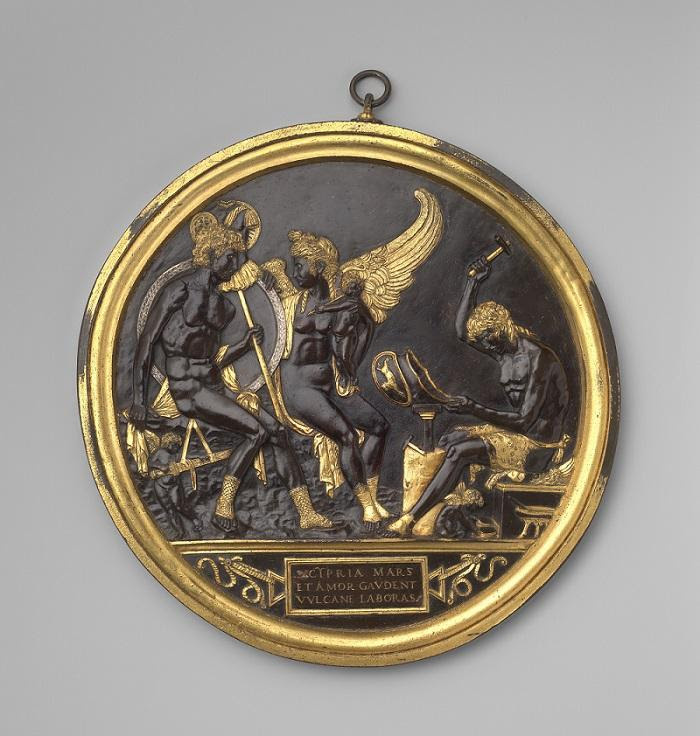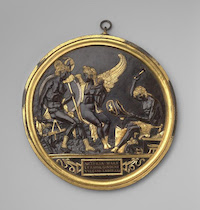
NEW YORK — The Metropolitan Museum of Art announced it has acquired an extremely rare bronze relief attributed to Gian Marco Cavalli, an Italian goldsmith, sculptor, print engraver and medalist who worked for the Gonzaga court in Mantua. Created around 1500, it is both the largest and one of the most technically sophisticated examples of a bronze roundel known from the early Renaissance. Lavishly embellished with gilding and silver inlay, the beautifully rendered configuration shows four figures from Roman mythology and provides new insights into the experimentation and impeccable craftsmanship that are the hallmarks of early north Italian bronzes.
“The bronze roundel is an absolute masterpiece, standing apart for its historical significance, artistic virtuosity and unique composition,” said the museum’s Marina Kellen French Director, Max Hollein. “It is a truly transformational acquisition for the Met’s collection of Italian Renaissance sculpture. We look forward to further studying and displaying this magnificent work, one that establishes Cavalli as one of the ingenious creators of the Gonzaga court style.”
Cavalli (born about 1454, died after 1508) collaborated for more than 30 years with Andrea Mantegna (1430/31–1506), the principal painter to the Gonzaga court in Mantua, and with Antico (circa 1460–1528), the Gonzaga family’s principal sculptor. Yet the attribution of works to Cavalli remained challenging until the discovery of the roundel in a British country house in 2003. The roundel may have been made for Isabella d’Este, Marchioness of Mantua (1474–1539), the most important woman patron of the Italian Renaissance.
Iris and B. Gerald Cantor Curator in Charge of European Sculpture and Decorative Arts Dr. Sarah E. Lawrence stated, “While the Met is rich in paintings and prints by Mantegna, and holds the largest collection of Antico’s gilt and silvered bronze sculptures outside Europe, there was no equivalent example in bronze relief in our collection. With this exciting acquisition, the Met is now one of the only museums in the world that can illustrate the fundamental collaboration between Mantegna, Antico and Cavalli under the patronage of Isabella d’Este.”
With an integral frame and a suspension loop so that it could hang on the wall like a painting, Cavalli’s roundel translates a complex pictorial narrative into the sculptural language of gold, silver and bronze, demonstrating the tightly bound relationships among painting, sculpture, drawing, printmaking and goldsmiths’ work at the Gonzaga court. The relief, an allegory celebrating harmony, shows Venus, goddess of love, subduing belligerent Mars, god of war, and all others under her power. It depicts the victorious golden-winged goddess enrapturing Mars with her gaze, while her husband Vulcan fabricates the war god’s helmet. The Latin inscription admonishes them: “Venus Mars and Love rejoice. Vulcan, you labor!”
The roundel’s symbolism expands upon the tradition of comparing Isabella d’Este to Venus, most famously depicted in the Parnassus (1497; Paris, Louvre) painted by Andrea Mantegna for Isabella’s studiolo (study room) in the Ducal Palace. Like Mantegna’s picture, the roundel also shows Mars, Venus, Cupid and Vulcan but in an entirely original conception drawn from a compilation of contemporary Gonzaga court poetry and popular romance. The roundel’s resonance with the art and literature associated with Isabella suggests she may have commissioned it, perhaps to complement the paintings displayed in her studiolo.
The Met plans to display the roundel in Gallery 536 by early March 2022.
Visit the website of the Metropolitan Museum of Art.



